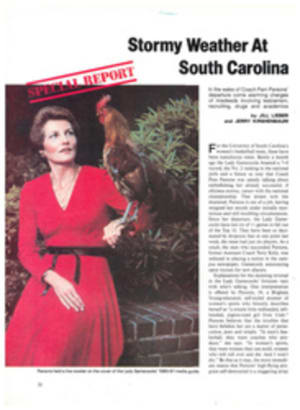
Boning up on the skeletons
Leave it to the fat man to sum it all up. The fat man is a bobsledder of the old school, comfortable with his bulk, his long sporting career showing in his gnarled hands and the ridges of whitened scar tissue across the bend of his nose. He's now a maintenance worker at the Mount Van Hoevenberg bobsled run at Lake Placid, and he steps out of his little warmup shack at the No. 8 turn and makes a pronouncement. On this —9° morning, his voice rings out crisply. "These——guys," he says, "have got to be out of their——minds."
Even cleaned up for publication, his assessment seems to make a certain gritty sense. For what the fat man has just seen is another human hurtling down the bob run aboard a 36"-long sled that rises only 2" above the track. What's more, the sledder was doing a belly-buster, facedown. And worse, he was holding his arms back along his sides and steering by means of minute movements of his head and shoulders. His chin rode an inch from the iced track, and as the little steel sled skittered around Big Shady turn, the rider turned his head slightly and the left side of his crash helmet rattled against the ice: Brrrraaaaappp! In another flash he was headed down toward Little S turn and Zig-Zag.
Maybe crazy, maybe not. The contraptions in question are called skeleton sleds, and the aforementioned rider is a member of the U.S. skeleton sled team. This may be the most obscure U.S. team in existence. The entire population of the U.S. skeleton team is five guys—four of them are sledders and the fifth is the manager. They've been a team for, oh, five months, and in a week or so, for better or worse, they'll represent all of us, the entire U.S. of A., at the world championships in St. Moritz. What's more, there's a campaign afoot to add skeleton sledding to the 1988 Winter Games; it was an Olympic sport before, back in 1928 and 1948. If it returns, these same guys will also probably be the U.S. Olympic team.
They'd desperately like to have more sliders. "Right now it's a lonely, sort of orphan sport," says Bill Hunt, the manager. Hunt, who's from Mont Vernon, N.H., is wistfully earnest about the skeletons. "Imagine if we could get a whole bunch of guys out, all of them bombing down this run and trying out for the team, just like they do in other sports," he says. "We could be like, you know, like a fraternity of sledders and all sit around comparing our cuts and lumps over a few beers in the evenings."
Sledder John Thoren, 36, of St. Albans, Vt. adds a recruiting note. "Riding the sleds looks a whole lot scarier than it really is," he says.
"First you feel panic. And then you feel a few touches of sheer terror. But then you get a sense of euphoria," says Pat Murtagh, of Mallets Bay, Vt.
Oh sure. The Lake Placid bobsled run, which is used in its entirety for skeleton sledding, is a rarity—one of maybe 10 in existence. It's the only one in North America and the fastest in the world. It offers three principal straightaways and 16 curves in a vertical drop of 488 feet, with all that fun squiggled into a mere 1,557 meters—a one-mile dash down the mountainside. The big guys on their two-and four-man bobsleds make it down in barely more than a minute, hitting about 80 mph in some spots. The world records, set on this track, are 1:01.79 and 59.73 for the two-man and four-man, respectively. But they are all sitting there like gentlemen; they're not belly-whopping down a glazed ice chute on a 13"-to-15"-wide rig (measured from runner to runner) and letting it all hang out.
No wonder that the fat man came out of his shack for a look. There are few sporting sights quite so stunning as the one of a skeleton sled and rider in full cry. They're buried deep inside the trench on the straightaways and then suddenly thrown high into the curves. G-forces compress and distort the sledders' bodies. All of this happens at 70 or so mph; there's a quick impression of legs slightly skewed and elbows out (though they're supposed to be held tightly closed), and in that split second one can actually see the slight turn of head that steers the sled. Then man and vehicle are gone—and in the rattle of their departure comes an odd realization that something vital was missing. Of course: There's no sled to be seen at that speed, just one frail human body hurtling past on the shining ice.
The theory is that, one day soon, the skeletons will be doing all this almost as fast as the two-man bobsleds; a less than 1:10 run is considered attainable, and a 1:05 is every sledder's dream. At Lake Placid last weekend the official U.S. team was barreling down the course in the 1:11 to 1:15 range, each rider arriving wide-eyed and exhilarated at the bottom. "Man!" says Thoren, fastest slider on the team so far. "When you think of how much faster we can go, wow!"
"And here we are," says Chris Leach, 34, of Swanton, Vt., a teammate. "Four guys who happen to have the sleds. You can't get much more amateur than that."
The skeletons perhaps represent one more step into the wonderful insanity generated by the luge, whose riders go down the run on their backs, toes first, and hanging on to a rope with one hand. The lugers, however, have their own tracks, no bob runs for them. Still, like the skeletons, luges are descendants of ancient sledding contraptions. Indeed, the skeleton is a direct offspring of the Cresta sled, whose famous run is at St. Moritz. The Crestas, however, offer such comforts as sliding belly boards for control and balance, and the riders take the run in an arms-out-front position. Actually, the traditional position for riding a skeleton is with hands gripping the front of the sled, but the U.S. team has opted for the more daring kamikaze position, with arms held back to lessen wind resistance, a technique that has been in use in Europe for several years. That way the head and softly rounded dome of the crash helmet become a sort of battering ram. If a kamikaze rider hits something head on, he is a cinch to break his neck all the way down to his kneecaps.
But that's it—the danger is part of the special kick. No guts, no glory. It's a nice irony that the mildest-looking member of the U.S. team is actually its fiercest driver, who doubles as the coach, trainer, ma√Ætre d', whatever. Timothy Rath is 33 years old, 6'1½" and 210 pounds, an explosives contractor from St. Albans, Vt.
"While the sled looks simple, it's really not," Rath says. "The thing can weigh from 66 to 90 pounds—your preference—and every sled has a sweet spot on it just like a tennis racket or a golf club. You get set up on it, find the center of gravity and get yourself in perfect balance, lying absolutely still; head down, your chin must be an inch off the ice. You never, never raise your head or shoulders—if you so much as look up one time, you start to lose control of the sled and then you could be in big trouble. Instead, you..." Rath drops his whiskery chin against his chest and then rolls his eyes upward, peering out from beneath his brows, "...instead, you peek out from under the edge of your helmet, like this. Got it? And if you do all of that correctly, without moving a muscle, you can virtually steer the sled by simply glancing in one direction or the other."
Swell, Timothy. Just fine. Then what is all this ungainly flopping about on the bobsled run, heads swiveling, legs all splayed apart, toes digging into the ice?
"Well, we're still learning," Rath says. "We're desperately trying to master the techniques—and here the world championships are just a few days away. I think it's fairly safe to say that, with nine or 10 countries and some 90 riders entered, that we're not going to come home with any gold medals. But a couple of weeks ago the Austrians were kind enough to send over Gert Els√§sser, Europe's best slider, to show us how. And while teaching us that head-down position, Elsasser told us, 'Ze nize thing about skeleton sledding is that, if you do it right, you can smell ze ice.' "
Thus is a national team built, maybe even a dynasty. In years to come, who knows, these guys might become the scourge of skeleton sledding the world over. A skeleton team can consist of up to 10 men, and women's teams also are possible, though not permitted yet in international competition. Anyone who wants to try out for next year's U.S. team has but to show up at Lake Placid on just about any frosty morning with sled and elbow pads. "Perhaps someday these hard times might be known as the good old days of skeleton sledding," Rath says.
Meanwhile, Hunt has been making the rounds, hat in hand. The U.S. Bobsled Federation contributed $2,500 to help send the team to the world meet in Switzerland; various equipment manufacturers have donated everything from shoes and boots to helmets and those glossy, skintight racing suits. One old bobsledder, eyeing the glistening fabric, murmured: "That stuff is so slick that if a fly tried to land on it, he'd slide right off and bust his ass."
And when the team gets to Switzerland, Hunt is going to attempt a coup. "Hardly anyone remembers," he says, "that skeleton sledding was an Olympic event at the Winter Games of 1928 and 1948 in St. Moritz. So we'd like to bid for the 1983 world skeleton championships to be held here at Lake Placid. And we'll invite the Yugoslavs, see? And then, perhaps in 1984, everybody will be talking about skeleton sledding at the Winter Games in Sarajevo. Now wouldn't that be something?"
It would be something, at that. Not a bad start for a gang of sliders who are just learning how to smell the ice.
PHOTO
Murtagh shows weak form, strong nerves.
PHOTO
The U.S. team at Mount Van Hoevenberg (from left): Thoren, Leach, Murtagh, Rath, Hunt.

